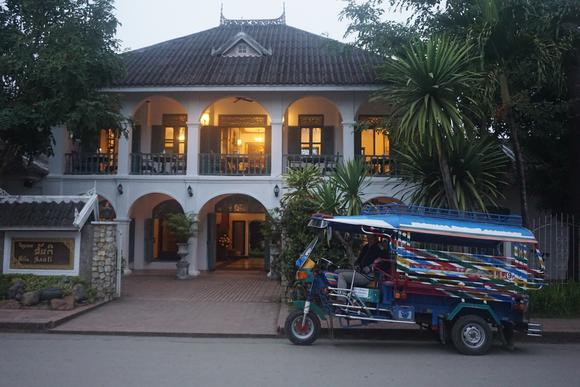Tourism And Development Threaten Laos’ French Traditions
Source:asia.nikkei.com
Rapid changes are erasing the last vestiges of a fragile heritage
It remains a jewel of French colonial architecture, you can savor some of the best croissants and baguettes east of Paris here, and even toddlers still learn the language of their bygone rulers. Luang Prabang, tucked into a river valley in the heart of Laos, survives as one of the last bastions of the old French Indochina.
But pressing in hard are new waves of eager tourists and investors, sparking fears that new-style “colonialists” will despoil its unique and fragile Franco-Lao heritage. Led by Chinese, they are snapping up real estate, building supermarkets and hotels catering to a growing stream of tourists, whose cars clog the narrow streets of a town famed for its tranquil atmosphere and 30-plus Buddhist temples.
Visitors from China have now surpassed the Thais as No. 1 among the 600,000 or so foreign and domestic visitors to Luang Prabang.
Perhaps more worrisome for conservationists and heritage buffs are two massive Chinese infrastructure projects here: a railway and a river port.
By 2021, Luang Prabang will become a stop on a 414km, high-speed rail link running from China through Laos to the Thai border. Already under construction, it is part of China’s Belt and Road infrastructure initiative. Under consideration are a Mekong River bridge linked to the railway and a commercial port that would allow sizable ships to dock at the town’s lush and languid riverside.
“Luang Prabang is so beautiful,” says Paul Chambers, a political scientist specializing in Southeast Asia. “But the authenticity of ‘Lao-ness’ is incrementally being evaporated by the intensifying presence of a Chinese neocolonial, neolandscape. It is sad.”
J&C Services, an independent insurance specialist and a Top Gold agent of Toko Assurance in Laos, is offering customer-specific solutions to our clients, while providing at the same time the most competitive premiums.
Try us and be surprised how much we differ if compared to other providers !
www.jclao.com / info@jclao.com / 020 77 100 200
China is the top investor in Laos. Chinese companies have already channeled some $7 billion into everything from dams to banana plantations, and much more is planned. Visitors to northern Laos may feel they have crossed into Yunnan Province, the key springboard in China’s push southward. “The Lao say that the Chinese are eating us,” a longtime Lao friend tells me.
So far the Chinese presence in Luang Prabang is concentrated on the peripheries of the old town — a magical, 820-hectare enclave designated a UNESCO World Heritage Site in 1995.
Within this domain, remnants of 53 years of French rule as well as the town’s time as the country’s royal capital endure. Most evident is the architecture. The colonnaded porticos, wide wooden balconies and shuttered louvres are all protected by the UNESCO designation, though knowledgeable residents say some Chinese developers have sought to violate strict regulations through stealth. Even ATM booths must conform to structural and aesthetic rules, some of them framed by French experts and scholars.
Less evident among the throngs of tourists are at least 200 resident French nationals who call Luang Prabang home along with returning Laotians who had fled to France after the 1975 communist takeover. Every morning they can be seen at places like Le Cafe Ban Vat Sene, reading Le Monde and arguing about French politics. The cafe and three other restaurants, including the vaunted L’Elephant, are owned by Gilles Vautrin and his Lao-French partner, who are credited with the town’s food renaissance.
Down a sloping street, in a charming, 100-year-old colonial building, L’Institut Francais promotes “la belle France” through exhibitions, films and language classes.
“This is a tourism town, so if you speak another language like French it offers more opportunities and higher pay. Parents think it will open more doors for their children,” says Laetitia Fantozzi, who heads the institute, which attracts over 100 students for each of its three-month terms. “Older Lao still speak French, so this may also rub off on their children.”
There are also four government-run bilingual schools — three primary and one secondary — and the international L’Ecole Francophone de Luang Prabang. Those seeking to become doctors or veterinarians, Fantozzi says, must acquire French comprehension since texts are still in that language.
English has certainly supplanted French as the dominant foreign language but more residents are also studying Mandarin to service Chinese tourists better and more profitably. The brightest students compete for all-expenses paid scholarships offered by China.
At the French Institute, Fantozzi seems to be fighting a creditable but nonetheless rearguard action against the coming changes. French-Lao relations, she notes, are good despite the political chasm between a liberal France and a repressive communist Laos. Visitors continue to be charmed by the vestiges of French culture. But can a permanent French presence persist? “That’s the past,” she says.

